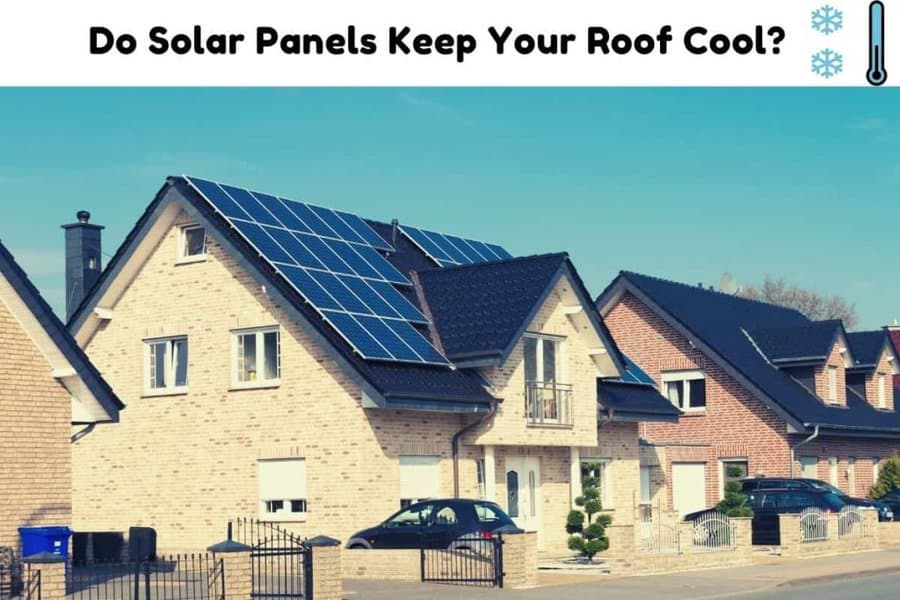The surface of the sun burns at about 10,000 degrees Fahrenheit. Graphene, the strongest material on Earth, melts at 7,658 degrees Fahrenheit. In summer your roof can reach temperatures of up to 150 degrees Fahrenheit.
What impact does having solar panels on your roof have? Does a roof with solar panels get hotter or cooler? Solar panels have a cooling effect on your roof. In this article, we are going to explore how much cooler a roof with solar panels is.
We are also going to look at whether the cooling effect of solar panels on a roof affects your attic and the rest of your home. Finally, we will look at how solar panels reduce climate change.

Do Solar Panels Have a Cooling Effect?
Solar panels have a slight cooling effect on roof temperatures. A scientific study revealed that solar panels can reduce the temperature on a roof by as much as 5 degrees Fahrenheit.
On a side note! If you’re in need of a reliable and high-performance portable solar panel, We strongly recommend the Jackery SolarSaga 100W Portable Solar Panel (Amazon Link).
With a high conversion efficiency and foldable design, this solar panel is easy to transport and set up, making it perfect for outdoor activities like camping, hiking, and RV trips.

The US solar cell technology used in this panel ensures that you get the most efficient and reliable solar charging possible.
There is also a 60W option that is more affordable (Amazon Link)
Heating and cooling contribute nearly 40% of your electricity bill. Solar panels can help you reduce your bill by providing you with a cheap source of energy and they can also make your home just a little bit cooler.
But how do solar panels keep your roof cooler? Solar panels keep your roof cooler by absorbing heat and providing shade.
How much heat do solar panels absorb?
Solar panels absorb up to 30% of the sun’s heat. This is heat that would otherwise be absorbed by your roof if the panels were not there. You could say they deflect some of the heat from your roof to themselves.
The cooling effect of shade
On a hot day, it is much cooler in the shade than out in direct sunlight. Aside from deflecting heat, solar panels also provide shade for your roof. Now instead of your roof being in direct sunlight where they will absorb more heat, they are shaded by your solar panels.
Besides shade, solar panels also create cooling convection currents in the gap between them and your roof. Provided your installer left a gap, and most installers do, a convection current is created in which warm air is drawn up and out while cool air is pushed down toward your roof.
Together, heat absorption, shade, and convection contribute to making your roof slightly cooler than it would be without solar panels. The more solar panels you have the more heat is deflected away from your roof.
Do Solar Panels Cool the Attic?
Most of the heat in the attic is the heat absorbed through the roof. Solar panels reduce the heat absorbed by your roof by as much as 38%. If your roof is absorbing less heat this means your attic in turn will be cooler.
In a revealing study done at the San Diego Jacobs School of Engineering, researchers sought to investigate whether there was a link between solar panels and the temperature of a building.
Using thermal imaging and infrared cameras they measured the internal temperatures of buildings with solar panels and those without. The results showed that buildings with solar panels on the roof were up to 5 degrees Fahrenheit cooler than buildings that did not have solar panels. (Source)
Do Solar Panels Need Airflow?
Solar panels need airflow to prevent them from trapping heat. A gap between solar panels and a roof will create a ventilation shaft that will allow cool air to flow in and warm air to be carried out from beneath your solar panel. This keeps both your roof and your solar panel cooler.
Before there were racking and mounting systems, solar panels were installed flush with the roof. There was no gap between the roof and the solar panel. This had a negative effect in that it trapped heat between the solar panel and roof causing both to heat up.
Not only did the lack of a gap create excess heat, but it also was not as structurally sound. Without a mounting system, solar panels were much more likely to get blown off in high winds. Nowadays solar installers use mounting systems to create the necessary gap that keeps your solar panel and roof cooler.
Also, check out our post titled “Do Solar Roof Ventilators Work? Is It Worth It!“
How Does Heat Affect Solar Panels?
Heat reduces a solar panel’s efficiency. Most people have the misconception that solar panels produce energy from the sun’s heat when this couldn’t be further from the truth. Photovoltaic solar panels convert light into energy. Heat harms a solar panel’s output.
With every 1°C rise in temperature above 25°C a solar panel starts to lose its maximum efficiency and produces less, not more energy. If you want a solar panel to produce more energy, you want it cooler, not warmer.
Some studies are looking into how we can produce energy from the heat generated below a solar panel but as yet they have not produced much by way of energy. (Source)
Do Solar Panels Help with Or Contribute to Climate Change?
Solar panels have the potential to make the biggest contribution to reducing climate change. Solar produces enough energy to offset over 100 million metric tons of carbon emissions every year. Solar can have a massive impact on reversing climate change and reducing carbon emissions. 28% of greenhouse gases in America are produced by electricity generation using fossil fuels.
Greater adoption and exploitation of renewable energy like wind, hydrogen, and solar would reduce these emissions. (Source)
| Sector | Emissions |
|---|---|
| Electricity generation | 28% |
| Transport | 28% |
| Industry | 21% |
| Commercial and residential | 11% |
| Agriculture | 9% |
Solar is the best bet for reducing carbon emissions for several reasons, some are as follows,
- Sunlight is abundant from which to draw energy. Sunshine does not need to be extracted or mined like coal, oil, or methane.
- It is simpler to implement at scale. Wind and hydroelectric power require large areas of land. Solar panels can be used on existing spaces that are lying idle like rooftops for example.
- Solar panels produce more energy than other renewable energy sources like wind.
- Solar is the cheapest solution to rising energy demand. It is cheaper to provide solar energy to places that are not connected to the grid.

